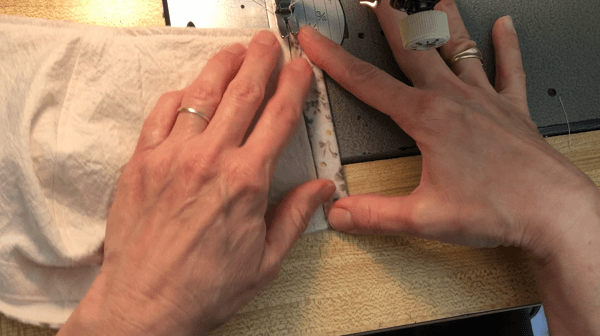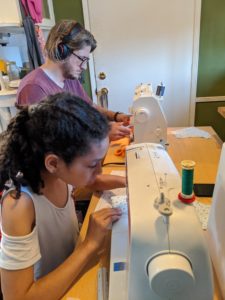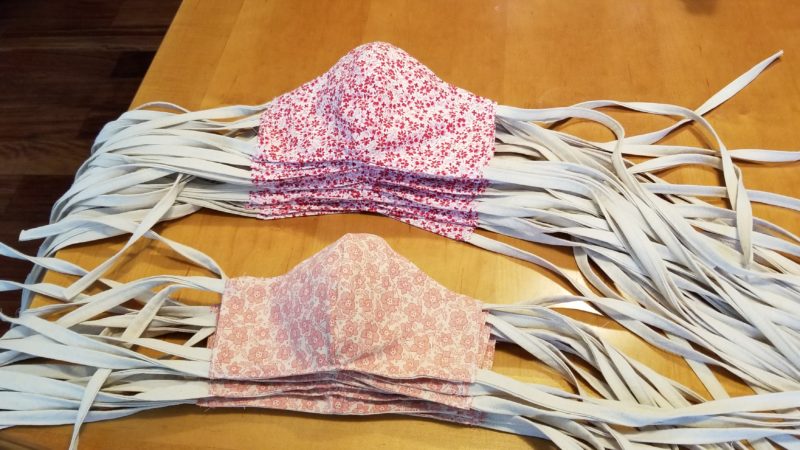Last month, when scene and costume shops were vacated by the safer-at-home order, the production staff at the School of Dramatic Arts were temporarily out of a workspace. But their hands didn’t idle for long; the School’s Head of Production Elsbeth Collins had an idea.
Colleagues of hers on the Production Managers Forum had proposed taking a break from the stage, instead using their equipment and resources to make face masks that could be worn with an N95 mask for protection. Hospital mask shortages and increasing COVID-19 cases indicated a pressing need for personal protective equipment donations, and the School’s skilled production team had everything they needed to jump right in.
“I thought, ‘aha! This could be a way to keep our staff working and productive,” Collins said.
She brought the idea to dean David Bridel, who responded quickly and enthusiastically. With a blessing from the School’s partners at the Keck School of Medicine of USC, the staff launched into assembly on Friday, March 20.
Socially distant distributions
By the next Wednesday, the team had distributed all resources and selected a pattern or two from the COVID Rangers website, and attended a video tutorial meeting with SDA costume technician Charlotte Stratton on sewing machine basics.

Costume technician Charlotte Stratton shows how to sew casing for ear elastics (Video courtesy Charlotte Stratton)
Hundreds of yards of muslin and fashion fabric were appropriately washed and distributed to project members in their homes. A startup team of about ten staff members sat down at their machines (some personal, some from SDA’s costume shop), and got to work.
Technical theatre manager CB Borger coordinated with Collins to allow for a divide-and-conquer model, where according to each staff member’s home resources, different parts of the project could be completed by different production experts. Borger mapped out a routine and a schedule, where he could pick up fabric cut and cleaned by those without sewing machines. Materials were left outside for social distancing purposes, and Borger redistributed to sewing experts, who would sew the masks into form and attach elastic for the ears.
A mask meeting of the minds
During this first week in particular, the group met often via Zoom to fine-tune the process and the model. Properties manager Hannah Burnham suggested ironing fabric after the wash to avoid wrinkling before sewing. Stratton found that straps could use more room for adjustment. Participants shared their tips and tricks and helped colleagues troubleshoot on their sewing machines.

Production technician Donavan Martinelli and his daughter sewing masks (Photo courtesy Donavan Martinelli)
By the end of the first week, the production team had manufactured almost 200 masks to be dropped off at Keck Medicine of USC, and Borger delivered the inventory to a grateful hospital on the health sciences campus. Word of mouth had spread about the mask effort, and the team began to grow. Some staff members even had help from family members, who donated their free time to contribute.
With the first donation receipt complete and more information flowing in about effective mask design, a few more staff members stepped in to streamline the blueprint. Head of technical direction Duncan Mahoney stepped in to provide cut wires from the scene shop that could be inserted into masks for shape around the nose, as requested by Keck and other medical entities. Filter pockets were added to some mask iterations, and team members were designated different sizes and models to provide the appropriate coverage for hospital employees. The team even received fabric donations from a few good Samaritans. Borger redistributed the new materials, and the staff went back to work. For the time being, the team is continuing to make masks with the intention of manufacturing and donating as many as possible.
“I’m really proud of my team,” Collins said. “Their willingness and work is a testament to their commitment to the School and the university.”
At the close of their second week in production, the dramatic arts dream team had assembled and donated almost 400 masks to Keck. As long as there are resources and demand, they will continue to contribute masks and materials, in service of the university community and the broader Los Angeles community.

Masks being dropped off at Keck Medicine of USC (Photo courtesy CB Borger)
To download mask patterns and contribute to your local hospital or healthcare professionals, click here for the COVID Rangers pattern, an easy rectangular mask, different-sized mask, and a more complex shaped mask.
